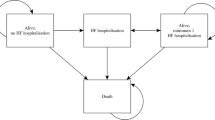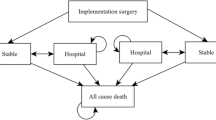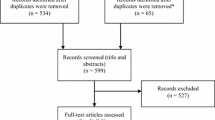Abstract
Background
Implantable cardioverter-defibrillator (ICD) therapy was traditionally applied in patients who survived a cardiac arrest or who experienced a symptomatic ventricular tachyarrhythmia. Its use in primary prevention (i.e. in patients who have yet to experience a serious arrhythmic event, but who are considered at high risk for sudden cardiac death) has become more common, and policy makers question whether ICD therapy should be reimbursed in these instances.
Objective
To assess the cost effectiveness of primary prevention ICD therapy versus conventional therapy from the perspective of the Belgian health insurance system.
Method
A lifetime 1-month cycle Markov model was constructed and populated with clinical and effectiveness data from the SCD-HeFT study and real-world Belgian cost data expressed in year 2005 values. Probabilistic modelling and sensitivity analyses were performed.
Results
ICD therapy results in 1.22 life-years gained (LYG) or 1.03 QALYs gained. The lifetime cost-effectiveness and cost-utility ratios were €59 989 (95% CI 35 873, 113 518) per LYG and €71 428 (95% CI 40 225, 134 623) per QALY gained, respectively. A cost-effectiveness ratio <€50 000 per QALY gained was obtained in 15.5% of 1000 simulations. Increasing the service life of the device from 5 to 7 years would improve the cost effectiveness to €57 229 (95% CI 32 568, 106 410) per QALY gained.
Conclusions
ICD therapy may not be judged cost effective for the primary prevention of death in patients with a SCD-HeFT profile in the Belgian context using current technology and patient selection. A combination of price reductions and increased service life of the device may alter this conclusion.










Similar content being viewed by others
References
Bryant J, Brodin H, Loveman E, et al. The clinical and cost-effectiveness of implantable cardioverter defibrillators: a systematic review. Health Technol Assess 2005 Sep; 9(36): 1–150, iii
Huikuri HV, Castellanos A, Myerburg RJ. Sudden death due to cardiac arrhythmias. N Engl J Med 2001 Nov 15; 345(20): 1473–82
Bardy GH, Lee KL, Mark DB, et al. Amiodarone or an implantable cardioverter-defibrillator for congestive heart failure. N Engl J Med 2005 Jan 20; 352(3): 225–37
Guidant. “Perceptions & reality”: training manual for Guidant representatives. Economics of ICD therapy: a healthcare system perspective. Diegem: Guidant, 2005
Van Brabandt H, Thiry N, Neyt M, et al. De Implanteerbare defibrillator: een health technology assessment. Brussel: Federaal Kenniscentrum voor de Gezondheidszorg (KCE), 2007. Report no.: D2007/10.273/21
Fletcher J. What is heterogeneity and is it important? BMJ 2007 Jan 13; 334(7584): 94–6
Moss AJ, Zareba W, Hall WJ, et al. Prophylactic implantation of a defibrillator in patients with myocardial infarction and reduced ejection fraction. N Engl J Med 2002 Mar 21; 346(12): 877–83
Zipes DP, Camm AJ, Borggrefe M, et al. ACC/AHA/ESC 2006 guidelines for management of patients with ventricular arrhythmias and the prevention of sudden cardiac death: executive summary: a report of the American College of Cardiology/American Heart Association Task Force and the European Society of Cardiology Committee for Practice Guidelines (Writing Committee to Develop Guidelines for Management of Patients with Ventricular Arrhythmias and the Prevention of Sudden Cardiac Death) Developed in collaboration with the European Heart Rhythm Association and the Heart Rhythm Society. Eur Heart J 2006 Sep; 27(17): 2099–140
Cleemput I, Crott R, Vrijens F, et al. Recommandations provisoires pour les évaluations pharmacoéconomiques en Belgique. Health Technology Assessment (HTA). Bruxelles: Centre fédéral d’expertise des soins de santé (KCE), 2006. Report no.: 28B
Institute for Clinical System Improvement (ICSI). Implantable cardioverter-defibrillators for the primary prevention of sudden cardiac death due to ventricular arrhythmias. Bloomington (MN): ICSI, 2005
Medical Services Advisory Committee (MSAC). Implantable cardioverter defibrillators for prevention of sudden cardiac death. MSAC Reference 32. Canberra (ACT): MSAC, 2006
Mark DB, Nelson CL, Anstrom KJ, et al. Cost-effectiveness of defibrillator therapy or amiodarone in chronic stable heart failure: results from the Sudden Cardiac Death in Heart Failure Trial (SCD-HeFT). Circulation 2006 Jul 11; 114(2): 135–42
Briggs A, Sculpher M, Claxton K. Decision modelling for health economic evaluation. Oxford: Oxford University Press, 2006
Federal Public Service Economy, SMEs, Self-employed and Energy. Key figure, indices [online]. Available from URL: http://www.mineco.fgov.be/informations/indexes [Accessed 2008 Aug 29]
Belgian Centre for Pharmacotherapeutic Information. Price table, class III anti-arrhythmics [online]. Available from URL: http://www.bcfi.be/ggr/index.cfm?ggrWelk=/nindex/ggr/stof/IN_A.cfm [Accessed 2007 May 24]
Hlatky MA, Mark DB. The high cost of implantable defibrillators. Eur Heart J 2007 Feb; 28(4): 388–91
Sanders GD, Hlatky MA, Owens DK. Cost-effectiveness of implantable cardioverter-defibrillators. N Engl J Med 2005 Oct 6; 353(14): 1471–80
Rice JA. Mathematical statistics and data analysis. Belmont (CA): Duxbury Press, 1995
Gyrd-Hansen D. Willingness to pay for a QALY: theoretical and methodological issues. Pharmacoeconomics 2005; 23(5): 423–32
National Institute for Clinical Excellence. Guide to the methods of technology appraisal. London: NICE, 2004. Report no.: N0515
Hauser RG. The growing mismatch between patient longevity and the service life of implantable cardioverter-defibrillators. J Am Coll Cardiol 2005 Jun 21; 45(12): 2022–5
Acknowledgements
No sources of funding were used to assist in the preparation of this manuscript. The authors have no conflicts of interest that are directly relevant to the content of this study.
Author information
Authors and Affiliations
Corresponding author
Rights and permissions
About this article
Cite this article
Neyt, M., Thiry, N., Ramaekers, D. et al. Cost effectiveness of implantable cardioverter-defibrillators for primary prevention in a belgian context. Appl Health Econ Health Policy 6, 67–80 (2008). https://doi.org/10.2165/00148365-200806010-00006
Published:
Issue Date:
DOI: https://doi.org/10.2165/00148365-200806010-00006




